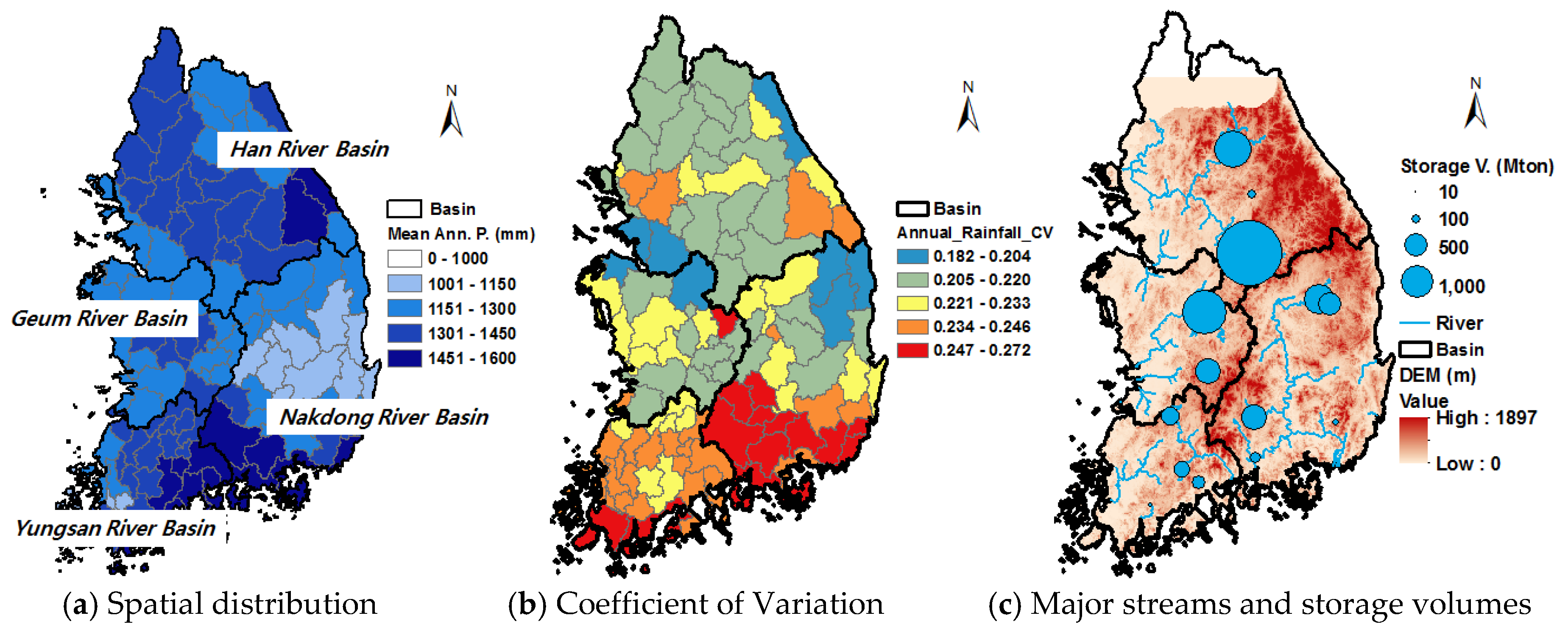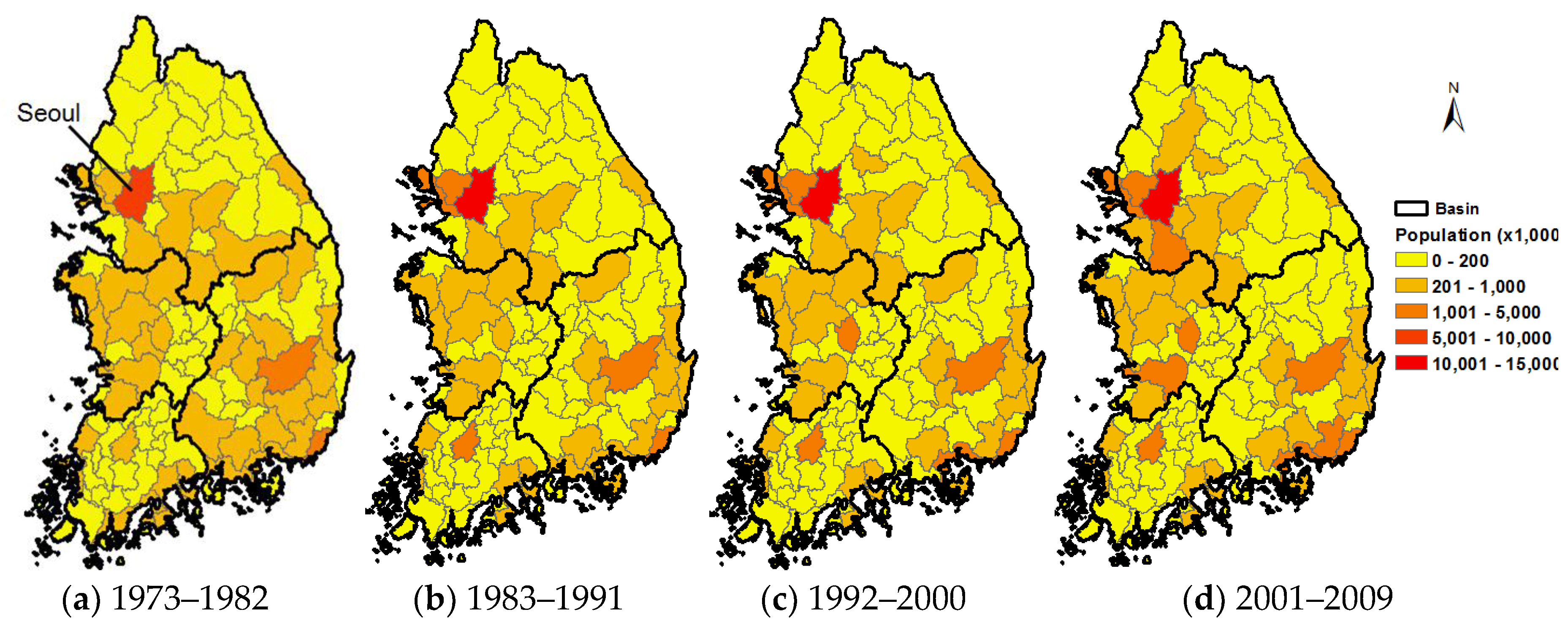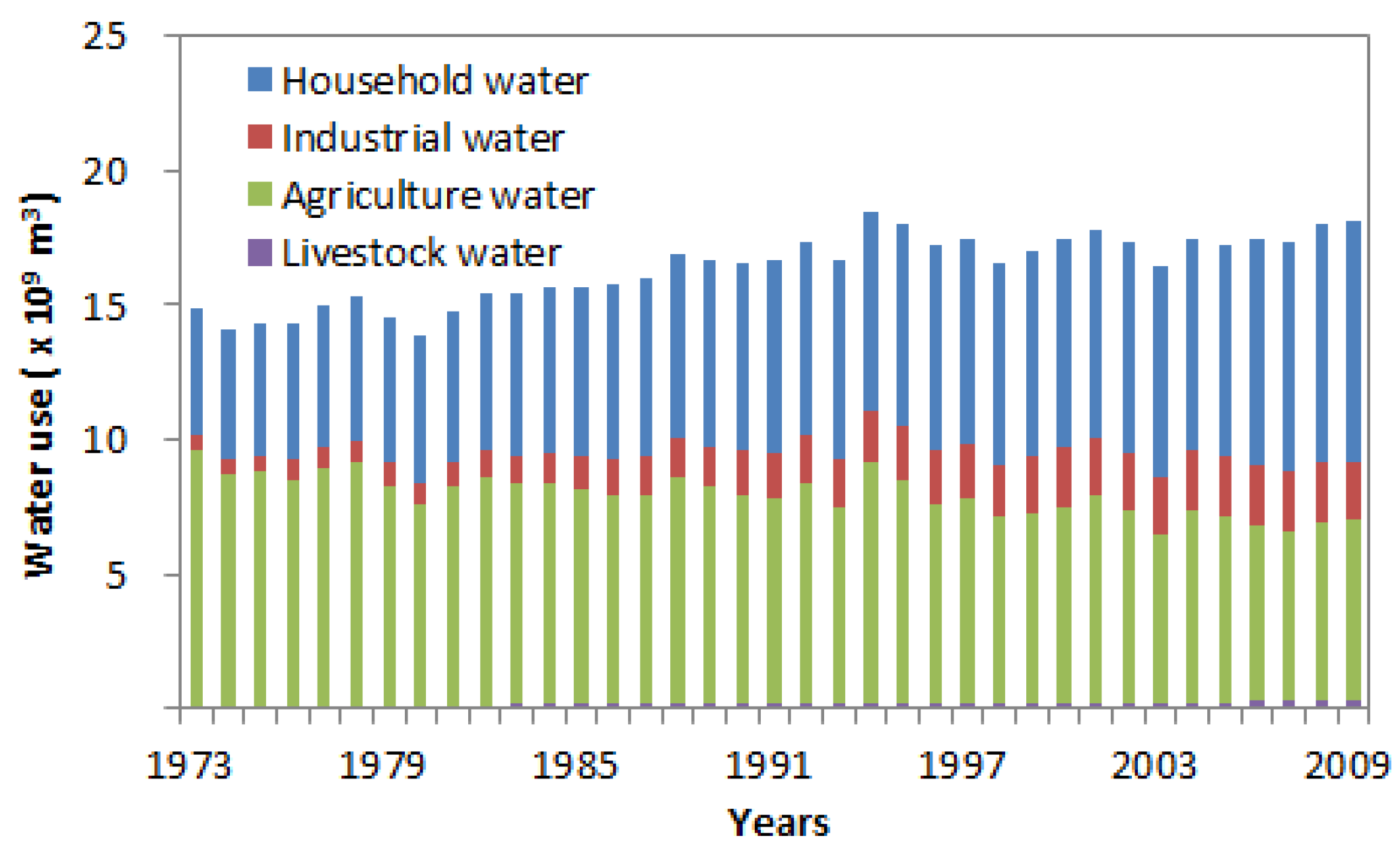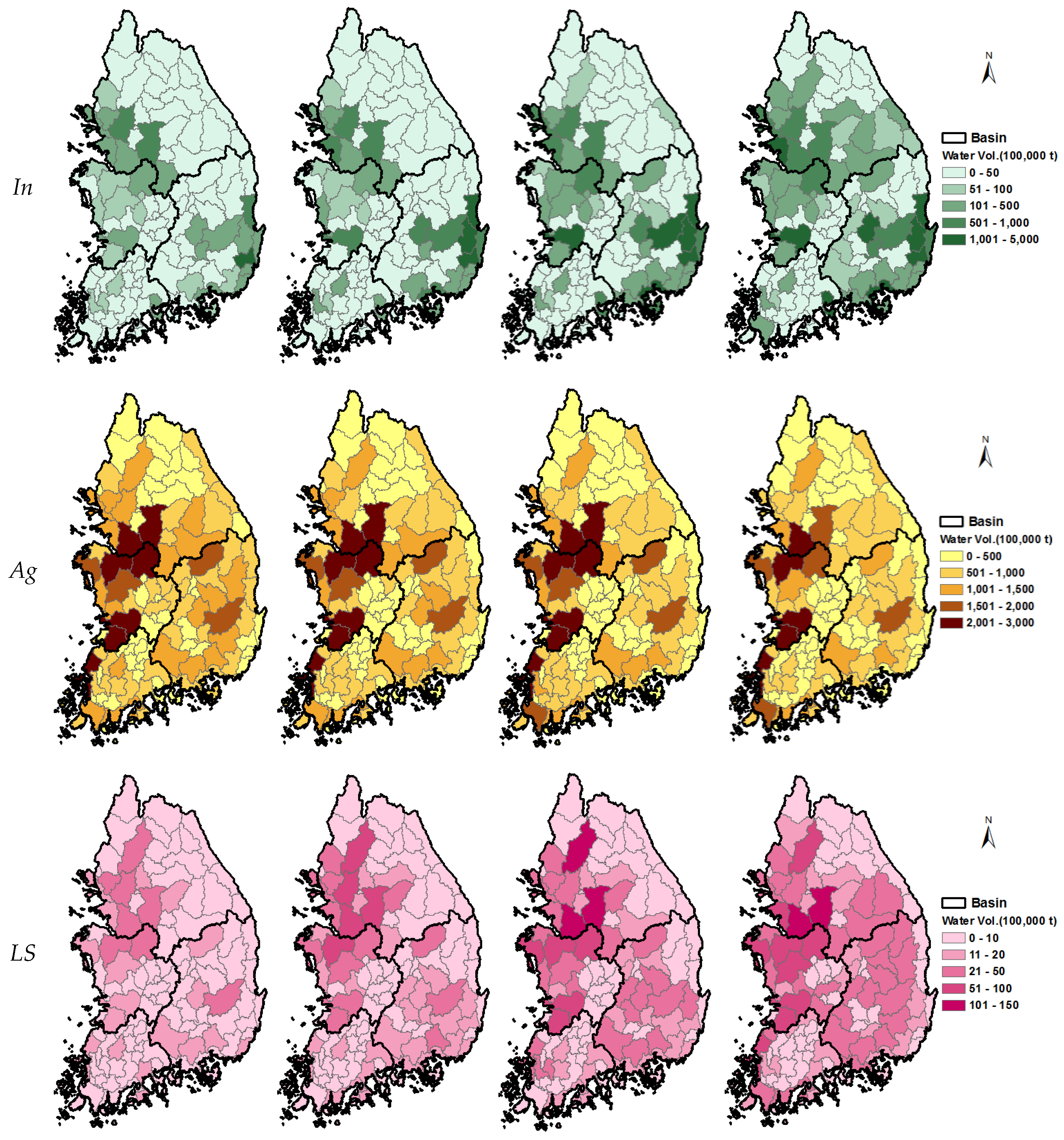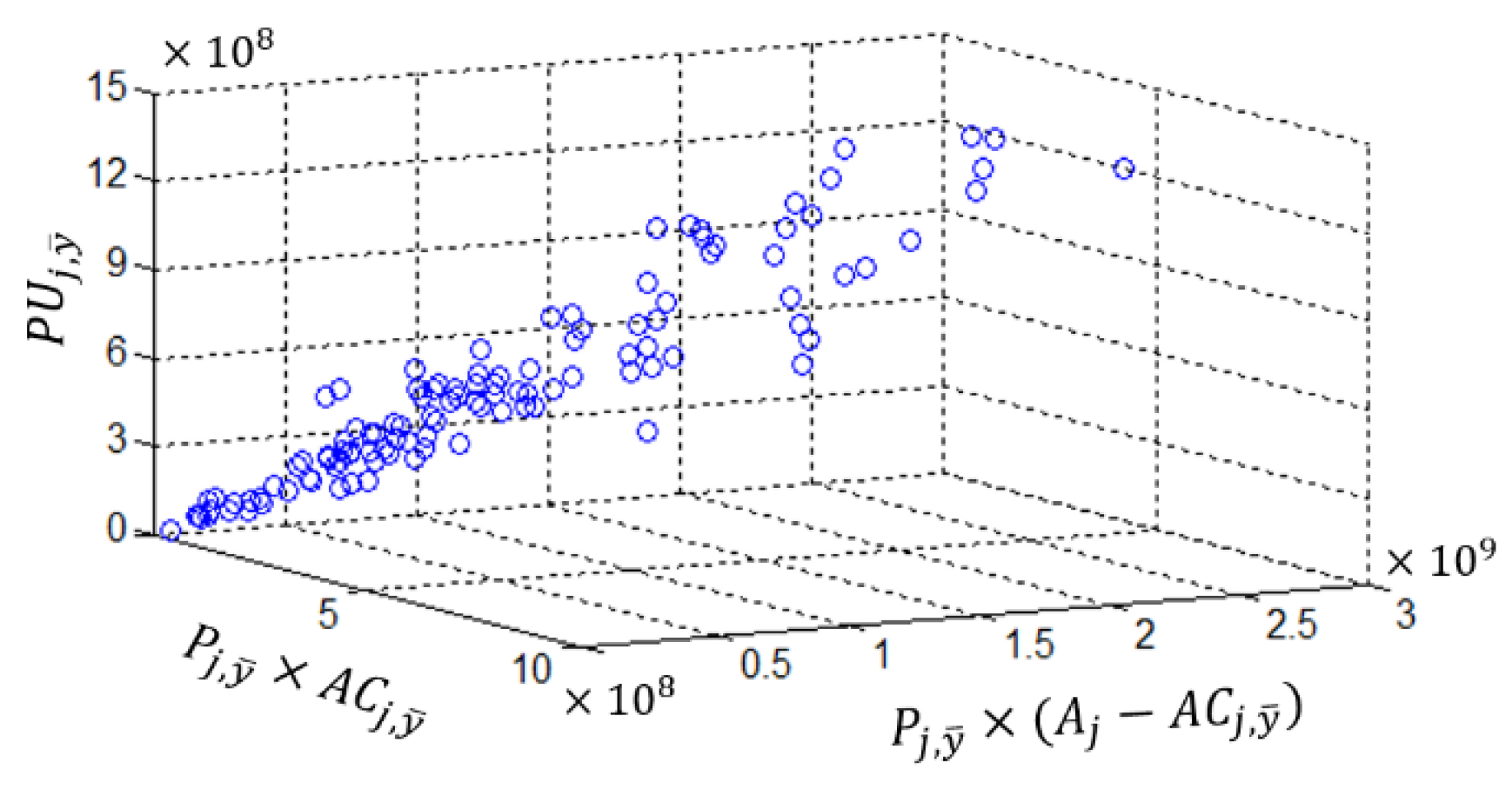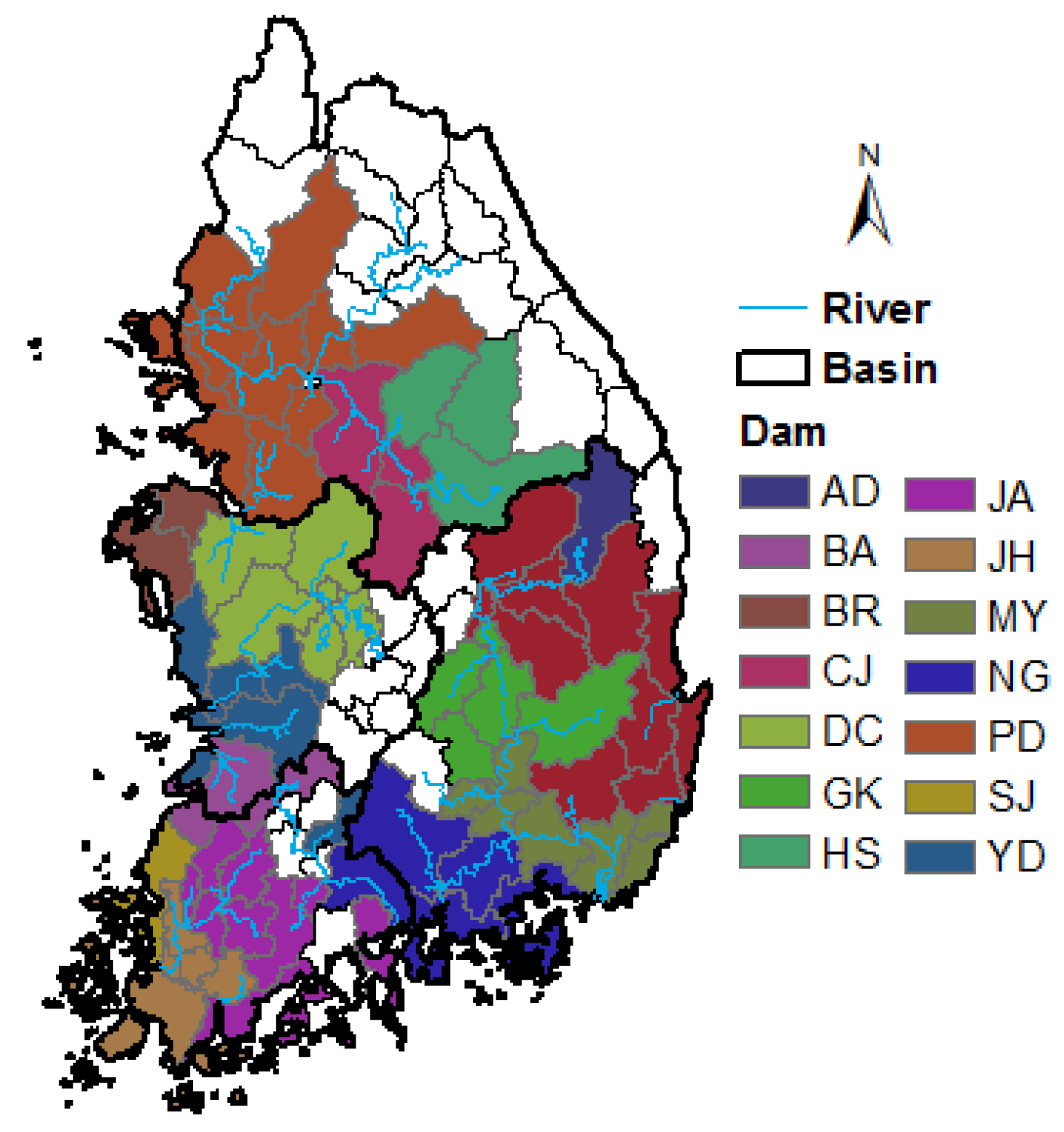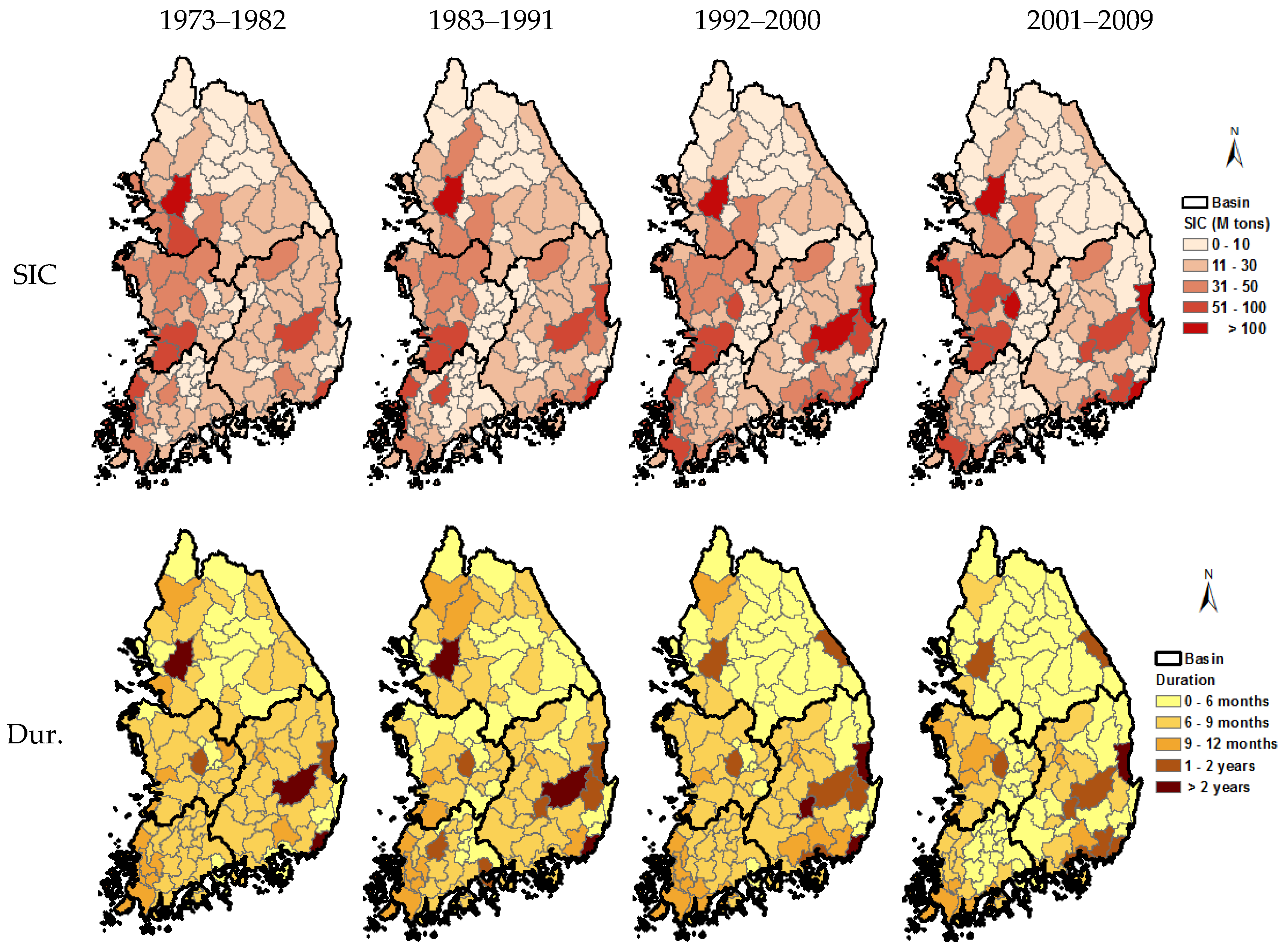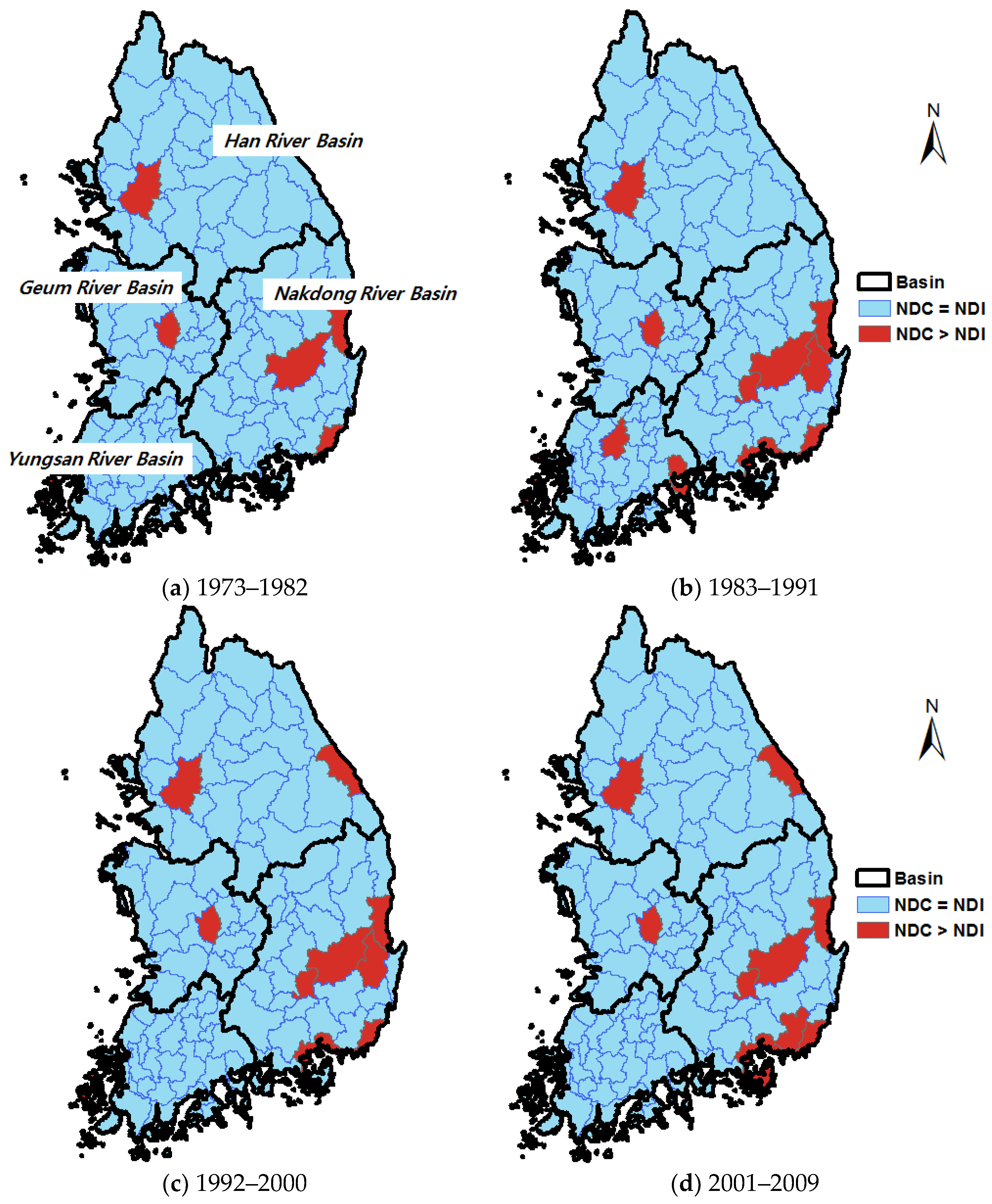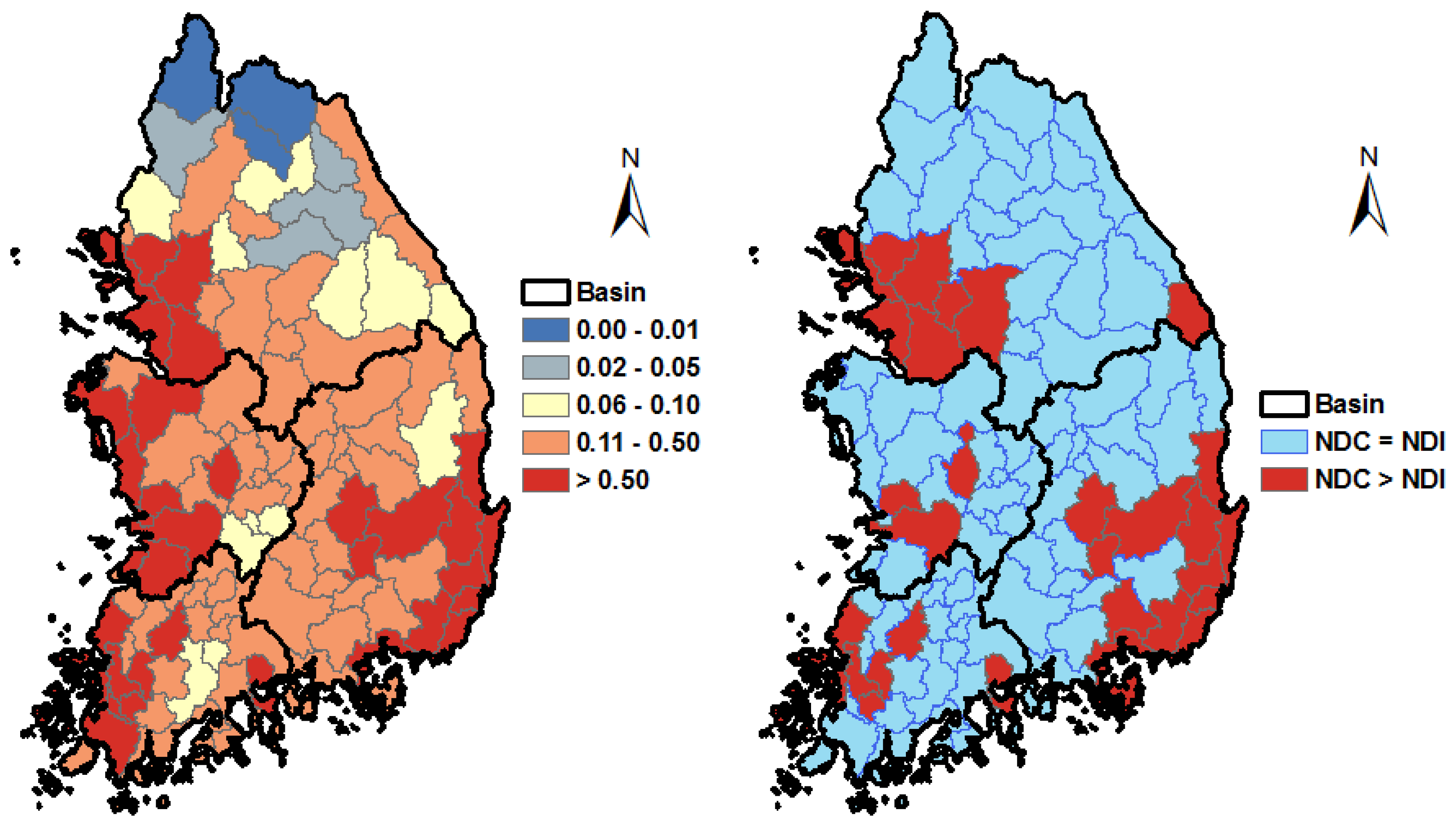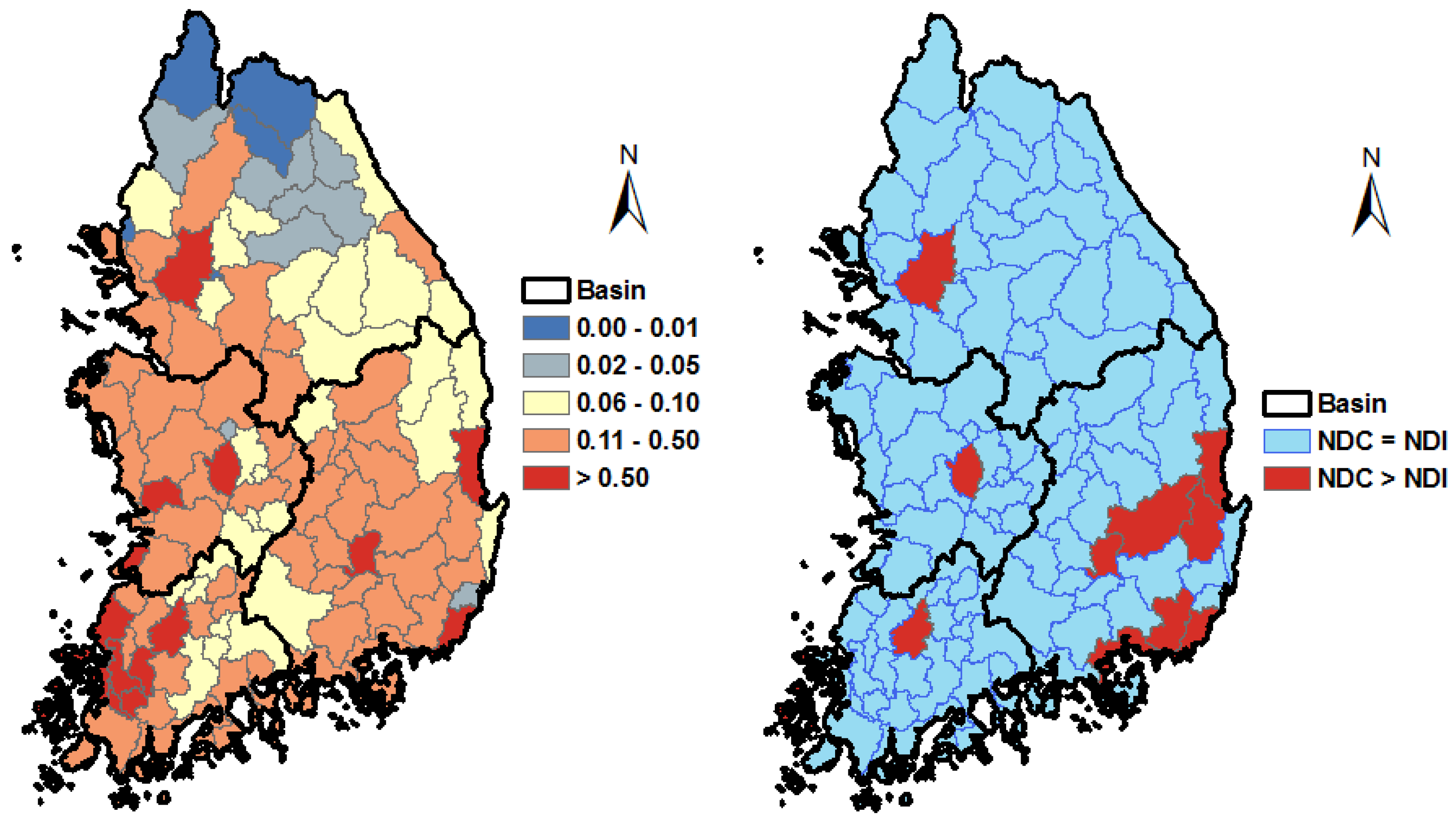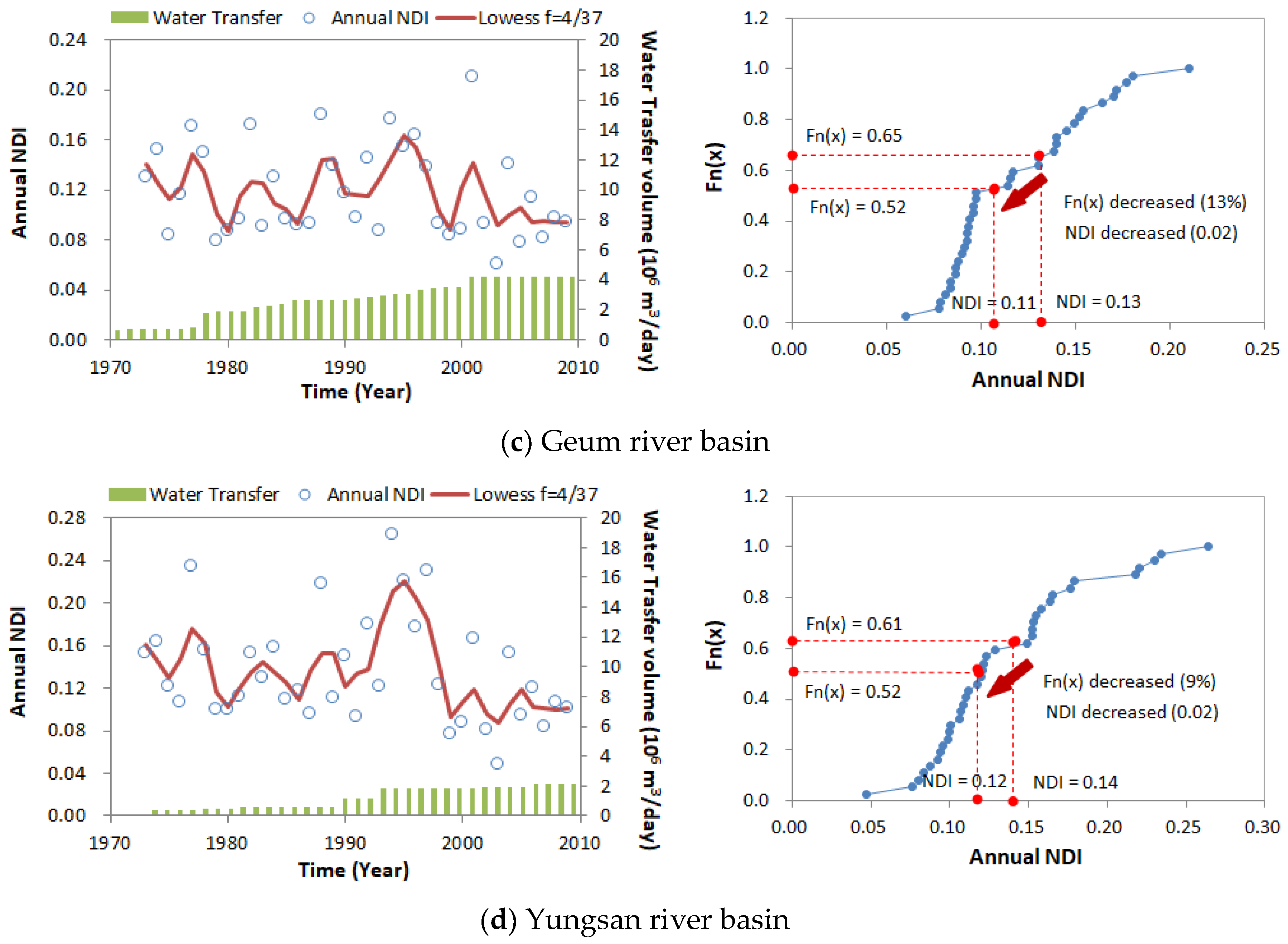3.1. Water Stress Indices
The Water Risk Indices used here were developed by Devineni et al. [
9] that are based on the sequent peak algorithm originally developed for reservoirs [
10,
11,
12]. The computation of these indices as presented in Devineni et al. [
9] is as follows:
For the
jth geographical unit we define the following quantities:
where
refers to the accumulated deficit,
is total water demand, and
is the total water supply volume, for geographical location
j and day
t and
y to a year. The corresponding normalized indices, are
where
is the average annual rainfall volume for basin
j estimated by multiplying the area and the average depth of precipitation.
The daily water deficit is calculated from the difference between the daily water demand and supply. These daily deficits are accumulated while setting negative accumulations to zero. The NDI is the maximum accumulated deficit in a given year in relation to the average annual precipitation and the NDC is the maximum accumulated deficit for the whole time period of interest as it relates to the average annual precipitation. Devineni et al. [
9] have also prescribed a comparison of NDI and NDC, through which we can assess whether a region is prone to multiyear drought risk and whether the resulting shortages will exceed the average renewable endogenous supply in the region or not. Nonetheless, unlike Devineni et al. [
9] who took an approximation approach based on a fraction of local precipitation as renewal water supply, in this present analysis, given the access to water resources data in South Korea, we considered precipitation, surface water and groundwater (i.e., all possible water sources) for water supply.
3.2. Data Collection and Processing
We compute the water risk for each sub-basin in South Korea. Water resources units in South Korea are classified into basins (low definition, four units), sub-basins (medium definition, 113 units) and watersheds (high definition, 840 units). Among them, sub-basin units have similar characteristics to the administrative districts. We collected the water supply and demand data for the sub-basins (113 units). 37 years of daily data on water supply and water demand from 1973 to 2009 are collected from the Water Management Information System (WAMIS;
www.wamis.go.kr). WAMIS provides data on hydrometeorology, basin characteristics, river flow, dam storage and operations, groundwater levels and water use.
Water demand (
) can be classified into household water use (
), industrial water use (
), agricultural water use (
), and livestock water use (
).
We assumed a constant daily household, industrial, and livestock water usage. We used a per-capita daily water usage of 359 L [
13] with the annual population data to estimate the domestic water consumption.
Annual industrial water use data for each sub-basin is available from the WAMIS database. Further, livestock water usage data for each sub-basin is available from the Korea Statistics website (
http://kostat.go.kr).
We quantify the agricultural water demand (
) as the estimated total crop water requirement for ten major crops cultivated in the country. For each cultivated crop in a sub-basin, we calculated the water use based on the estimated crop growth stage, and FAO recommended reference crop evapotranspiration on a daily time scale [
14].
Daily air temperature data is used to estimate the potential evapotranspiration for each sub-basin based on the Penman Monteith method [
15]. The Penman Monteith method is recommended as the standard method for estimating the evapotranspiration if the relevant data is available. Time series of the crop area planted is obtained from the Korean Statistical Information Service (
http://kostat.go.kr).
The time series of the estimated water demands from 1973–2009 is shown in
Figure 3. Decreasing farm area over the 37 years led to a reduction in the demand for agricultural water (by about 29.3%). However, due to the increase of household water demand (by about 88.9%) caused by the population increase and industrial water demand (by about 323.1%) caused by the economic growth, the overall water demand has increased by about 21.7%.
Figure 4 presents the spatio-temporal distribution of average water use for each sector over the last four decades (1973–1982, 1983–1991, 1992–2000, and 2001–2009). Notice the spatio-temporal shifts in water use patterns.
The water supply (
) is classified into what is available as a fraction of the direct precipitation as the renewable water resource in each sub-basin (
), the water supply available from reservoirs as surface water resource (
), and groundwater supply (
). The relevant data were collected through WAMIS.
Precipitation supply,
PUj,t,is estimated as shown in Equation (8).
where
is the precipitation for any day
t over a basin
j.
is the geographical area of the basin and
is the net cropped area of any day
t for the basin.
determines the effective rainfall [
14] that the crops can utilize from the total rainfall in a day over the net cropped area.
determines the amount of rainfall that can be harvested and used from the non-cropped area (
). The parameters
and
vary regionally and parametrically based on the information available. They conceptually embody the processes one could model for bare soil evaporation, soil moisture dynamics, and runoff generation [
9].
In this study, the coefficients
and
are developed using information on an annual average water balance. The annual average renewable water supply based on precipitation in each basin, which is the difference between precipitation volume in each basin
) and outflow volume (
), can be expressed as shown in Equation (9).
We obtained the annual average runoff data (
) for each sub-basin from WAMIS. Using Equations (8) and (9), we fit a multiple linear regression for precipitation use (
) based on the precipitation on farmland (
) and utilizable water on the non-farm land (
; see
Figure 5, Multiple correlation coefficient 0.992, R
2 0.984. Accordingly, 0.52 was used for
and 0.43 was used for
.
To determine the reservoir supply (
), the change of storage volume (
) according to inflow volume (
) and outflow volume (
) as shown in Equation (10) is estimated for each reservoir.
where
refers to the reservoir storage volume,
refers to the minimum storage volume, and
refers to the maximum storage volume.
The total reservoir inflows accounting for trans-basin diversions (See
Figure 6) and reservoir outflows as recorded in the database were used for these calculations.
Table 1 shows the information about the multipurpose dams, which have a large water supply volume, among the reservoirs considered in this study. Some sub-basins around a dam can use the water through water transfer facilities as long as the quantity of water in the dam is sufficient for transfer.
For underground water supply (), the data estimated as the use of underground water in each unit area were converted to daily data for utilization. Here, it was assumed that the intake of the underground water is available for the whole period from the data of the Water Management Information System.
3.3. Assessment of Water Stress
Water deficit is defined as the difference between the water demand and renewable water supply. Typically, a water deficit occurs because of an increase of water demand or decrease of water supply in spite of the development of a new water source, as shown in
Figure 7. The maximum accumulated deficit estimated over an n-year period (SII) measures the potential impact of multiyear droughts in the n year period. The measure provides insights on the time-evolving vulnerability to drought arising from changes in the climate and from that due to changes in non-climatic conditions (e.g., demand). It also provides a robust planning measure of the ability to meet the demand without failure for the worst dry periods in the time period. One can develop effective planning strategies for the managers to minimize the drought impacts in the current or future climate and demands.
The cumulative deficit accounting measure also provides other important planning characteristics like the duration, severity and recovery time for the droughts [
16].
Figure 7 provides a schematic of how we compute these attributes. The period or the time until the maximum cumulative deficit (peak) is defined as the drought critical duration when the cumulative deficit creeps from zero to the maximum cumulative deficit. This is when the system is most vulnerable. The maximum cumulative deficit is defined as the drought severity. The time from the maximum cumulative deficit to the time the deficit recedes back to zero is defined as the recovery time.
The drought severity (SIC, Stress Index Cumulative) and duration were estimated for each of the four decades (1973–1982; 1983–1991; 1992–2000; 2001–2009) and the spatial distributions in the each period are shown in
Figure 8.
The SIC, and duration have decreased spatially in the Korean peninsula, but their magnitudes have increased in some sub-basins (
Figure 8). This is primarily due to the movement of population and the addition of new reservoirs as water sources.
Based on SIC estimation for all basins, the corresponding normalized estimates, NDC, were estimated using the Equations (4) and (5) to quantify the extent of water stress in each decade. The extent of the water stress was classified into 5 criteria, as “Very Good (0–0.01)”, “Good (0.02–0.05)”, “Mediocre (0.06–0.10)”, “Serious (0.11–0.50)”, and “Very Serious (more than 0.50)” as per the published white papers for the drought event in 2001 as the first report for drought assessment from the Korean government that are the Report of the 2001 Drought Investigation Record in Korea [
17]. These results are shown in
Figure 9. The
Figure 9a,b show the water stressed areas in the 1st period and 2nd period. A large number of regions were found to be water-stressed. This may be a manifestation of demand increase in the urban regions during these decades.
Figure 9c,d show the distribution in the 3rd period and 4th decades. The water stress in many regions was found to have been resolved or have decreased compared with the 1st and 2nd periods. Specifically, the Han River basin was found to be safe from the risk of water stress. However, the Nakdong River basin, Geum River basin, Yungsan River basin were found to have significant number of water-stressed regions at more than serious levels, although with slight improvement from the 1st and 2nd periods.
With further investigation of NDI and NDC, we can recognize the regions that are susceptible to persistent drought. The spatial distribution of this comparison is shown in
Figure 10. The sub-basins shown in blue have NDC equal to the maximum NDI that means multi-year droughts do not have an impact over that of the driest year the historical period. These sub-basins typically are repetitive, which increases during the dry spell and decreases again with the advent of rains. The sub-basins under this category have high average annual precipitation and low inter-annual variability in rainfall. This implies that within year storage that can tap the seasonal rains will be sufficient to satisfy the water demands. This can preferably be satisfied by small scale and decentralized storages like small dams and water demand management, all of which are sufficient to satisfy within year demands and requires no further large scale infrastructural planning for carry over storage.
The sub-basins marked in red have NDC greater than the max NDI. These regions normally have high water deficits, experience periodic multiyear droughts and require large inter annual or carry over storages to meet the existing demands. The metropolitan cities, such as Seoul, Daegu, Busan, and Daejeon and the Nakdong River basin are the most vulnerable among the basins. As shown in
Figure 1a, a comparatively smaller amount of precipitation is identified in the Nakdong River basin together with the increase of urban population.
Trends based on the 37 years of NDI (water stress) data, and its influence factors were assessed using the Mann-Kendall test [
18,
19].
Figure 11 shows the results from the test for precipitation, total demand, and annual NDI in each sub-basin. The red color indicates that the value has an increasing trend with statistical significance at the 95% confidence level. Similarly, the blue color indicates that the value has a decreasing trend with statistical significance at the 95% confidence level. The light yellow color indicates no statistically significant trends. Precipitation (
Figure 11a) has increased significantly in the Han River basin, the upper stream of the Nakdong River basin. Total demand (
Figure 11b) has increased significantly in mid-lower stream sub-basins of each river basin, however, it has decreased significantly in upper stream sub-basins and most sub-basins in the Yungsan River basin. Annual NDI (
Figure 11c) has decreased in most sub-basins of the Han River basin and many sub-basins of other basins, but has increased in some sub-basins of urbanizing area (
Figure 2). These results explain that although precipitation has increased significantly in the Han River basin, expansive population growth in conjunction with the water resource development like dams and withdrawal facilities impacted significantly on decreasing water stress in South Korea.
